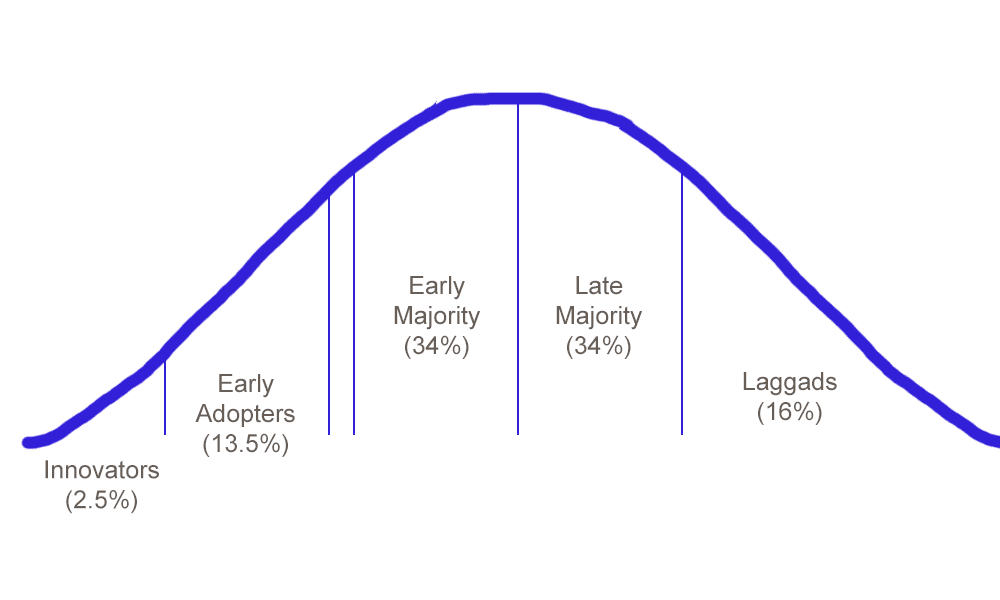Where are Agile and Scrum on the adoption curve? What about Kanban? XP? SAFe? Waterfall?
This is what we recently asked attendees at the London Agile Discussion Group.
What is the adoption curve?
The Diffusion of Innovations, or adoption curve, seeks to explain how, why and at what rate new ideas and innovations spread. The concept dates back over a hundred years and started gaining traction when it was used to examine how farmers were adopting new crops, equipment and techniques in the 1920s. In 1962, Everett Rogers gave us a fuller theory that we now know as the Diffusion of Innovations.
Rogers proposed that a small group (about 2.5% of the whole) of forefathers, which he called ‘innovators’, pick up an idea. These Innovators have a high tolerance to risk and sufficient financial stability to be unaffected if the idea fails. Next come the ‘early adopters’. These are the opinion leaders, who are financially secure, educated and have a wide social reach. The idea is still not widely adopted (at this point only about 16% of potential users are on board). Failure is still very much an option.

If adoption continues, the next group to come on board are the ‘early majority‘. This group still holds above average influence, but are not the thought leaders. Once they adopt the idea, adoption is at the half-way mark.
Next is the ‘late majority‘ who adopt ideas after the average participant and often approach innovation with a high degree of skepticism. They have a below average level of influence and are risk averse. Finally, there are the ‘laggards‘ who are the last to adopt an innovation. They have little or no influence and generally prefer traditions to new ways of thinking.
Although the world has got a lot more complicated since Rogers’ era, it’s still interesting to consider adoption using his curve.
So where are the ideas such as Scrum on the curve?
This all depends on how you are defining the ‘population’ for adoption. For example, are we asking where Agile is in terms of adoption across the world, in Europe, the UK or just in London? Also, are we referring to adoption in all businesses or just technology organisations?
In order to move the discussion on, we agreed to think in terms of knowledge work in the UK.
So where would you put the following?
- Agile
- Scrum
- Waterfall
- Kanban
- SAFe
- XP
- [insert your approach here]
What did we think?
We were a very small group (due to running it the day after a double bank holiday) so take the outputs with a pinch of salt and let us know if you disagree.
- Waterfall: everyone said this was with the laggards
- Scrum: after a bit of discussion, we settled on early majority
- Agile: most thought this was also with the early majority but some felt it was with the early adopters
- Kanban: most thought this still to be with the early adopters but a small minority thought it was with the early majority
- SAFe: Most felt this was still with the innovators but some thought it had made it to early adopters
There was an interesting discussion about whether Kanban and SAFe will (and whether people wanted them to) get over the chasm for mass adoption.
Only time will tell.
If you’d like to run this yourself, here is our PDF explaining the various groups.

Thanks very much for sharing this. I think we’re still very much in the early adopter stage. My rationale is that while many organisations have teams practicing Agile XYZ, most of these organisations have yet to foster a systematic environment that allows the full success potential of said teams, i.e. Business/Enterprise Agility.